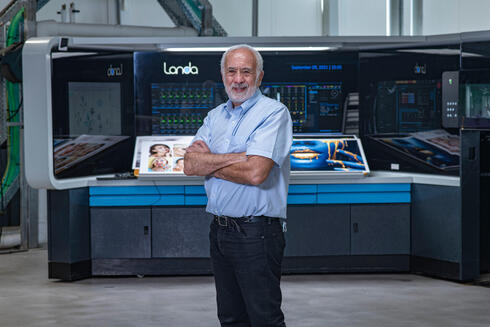
HP and FIMI emerge as potential buyers for Benny Landa’s troubled printing company
The international printing and computing giant, along with a major Israeli investment fund, are the only entities to have expressed interest in acquiring Landa Digital Printing, which is currently under a court-approved stay of proceedings. Any buyer will likely acquire the company by assuming its over $500 million in debt, subject to a negotiated haircut for creditors.
Only two parties have expressed interest in acquiring Landa Digital Printing, the high-profile digital printing company founded by Benny Landa. Calcalist has learned that international printing and computing giant HP and leading Israeli investment fund FIMI, managed by Ishai Davidi, are currently evaluating the company. Representatives of both entities visited Landa Digital’s offices in Rehovot last week and met with senior executives to assess the situation.
While HP is a natural candidate, having previously acquired Landa’s Indigo venture in 2002 for $830 million, FIMI’s involvement is more surprising. The fund has not traditionally invested in the printing industry, a space typically dominated in Israel by the Fortissimo fund, which, notably, has not taken part in this process.
Landa Digital Printing, which has raised a total of $1.3 billion, entered a severe cash flow crisis that led the court to approve a two-month stay of proceedings on July 10. During this period, the company will attempt to find a buyer or investor. CPA Shlomi Filiba and Adv. Sigal Rozen-Rechav have been appointed as special administrators to oversee the process.
Benny Landa, who invested $220 million of his own money in the company, holds a 36.7% stake, with an additional 4.6% owned by Landa Labs, also under his control. The remaining shares are held by foreign investors who contributed $971 million in equity and $353 million in loans later converted into equity, now considered debt. The company’s principal investors include German billionaire Susanne Klatten through the Altana chemicals group and the SKion digital printing company she owns, as well as the Winder investment firm of Sweden’s Rausing family. Both declined to inject further capital, prompting the request for creditor protection.
Following his success with Indigo, Landa envisioned a second revolution in printing, this time based on proprietary nano-pigment ink. The 55 printing machines developed by the company are heavy (weighing 30 tons), costly (around $3 million each), and require ongoing, expensive maintenance due to the specialized ink. Designed for industrial-scale jobs, they are not suited to commercial or home printing.
Landa hired investment bank Nomura to lead the search for investors, reportedly due to the bank’s strong ties in East Asia. Nomura opened data rooms to numerous global players, including Canon, Agfa, Fuji, Epson, Xerox, and Brother, but only HP and FIMI moved forward with in-depth reviews. Even so, FIMI’s involvement does not guarantee a bid, while HP’s interest is viewed as more strategic, given potential synergies between its core printing operations and Landa’s high-end machines. Some customers already use both platforms.
Despite the attention, shareholders may see little return, given Landa Digital’s overwhelming debt of NIS 1.74 billion (approximately $513M), of which NIS 1.43 billion ($421M) is owed to shareholders. The rest is owed to suppliers, employees, and Mizrahi-Tefahot Bank. The company’s capital was primarily invested in R&D, production, assembly (components are provided by suppliers and assembled in-house), and establishing an international sales network.
Data obtained by Calcalist shows Landa Digital posted losses totaling $312 million over 2022 and 2023. Revenue rose from $35 million in 2022 to $47 million in 2023, but losses deepened from $148 million to $164 million over the same period.
Related articles:
The company initially projected breaking even within five years. However, Calcalist has learned that it recently presented a revised business plan to potential investors, including a dramatic $60 million expense reduction aimed at achieving breakeven in 18 to 24 months. The plan involves raising prices for service contracts, which currently offer fixed rates for ink and maintenance, and reducing material costs through renegotiation with suppliers.
Regardless of the final buyer, it's already expected that many of Landa’s printing machines will be sold off, with others potentially scrapped. Some may revert to traditional offset printing. Industry insiders say Landa, a visionary and by all accounts an honest entrepreneur, did not ultimately spark the revolution he had hoped for.
Any buyer will likely acquire the company in exchange for assuming trimmed-down debt. If multiple bids are submitted, the winner will probably be the one offering the smallest debt haircut. While Landa hopes to deliver value to shareholders and preserve the company’s legacy, it's increasingly unlikely that shareholders will recover their investments.
